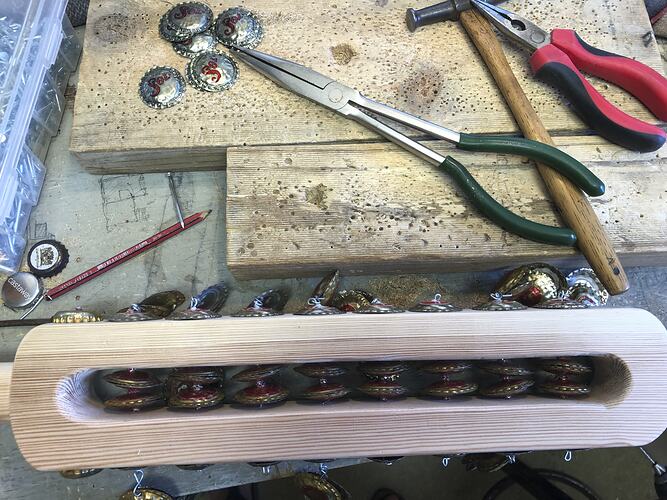Summary
Digital colour photograph of a section of a sparrow lagerphone in the process of being made by Jazmina Cininas in her studio, Melbourne, 2021. The photograph was also taken by Jazmina and shows the partially completed section with beer bottle tops and tools and materials in Jazmina's outdoor studio.
The lagerphones created by Melbourne artist Jazmina Cininas take the iconic Australian bush band musical instrument and adds the shapes of Baltic nature motifs to evoke a visual, auditory, and poetic reimagining of Lithuanian traditions. Artworks in their own right, the lagerphones serve as percussive instruments, which Jazmina first began making for the Melbourne-Lithuanian folk ensemble, The Lost Clog, when she joined them in 2011.
This image is one of a collection of 16 digital-born photographs relating to the creative activities of Jazmina Cininas. Several document her process of making her Lithuanian lagerphones (one lagerphone, 'Vilkas' (Wolf), is in the museum's collection HT 57615 ); and others document performances by Melbourne-based Lithuanian folk ensemble The Lost Clog of which Jazmina is a member. The collection also includes two video works (Tureja Liepa Liaj Taduvela and Balnok Tornai Bera Ziraga) by film director Mark Baikaitis for which Jazmina was executive producer and art director. They capture The Lost Clog's performances of two very different Lithuanian folk songs (all featuring the lagerphones), shot in 2021 on Wurrundjeri Country in Warrandyte and Kangaroo Ground.
Physical Description
Digital-born colour photograph
Significance
The lagerphones created by Melbourne artist Jazmina Cininas take the iconic Australian bush band musical instrument and adds the shapes of Baltic nature motifs to evoke a visual, auditory, and poetic reimagining of Lithuanian traditions. Artworks in their own right, the lagerphones serve as percussive instruments, which Jazmina first began making for the Melbourne-Lithuanian folk ensemble, The Lost Clog, when she joined them in 2011. The Lost Clog performances bring the lagerphones to life through their approach to weave a narrative song cycle of seasons, love, and loss from archaic Lithuanian folksongs. Jazmina's artistic and music practice offers an acknowledgement and celebration of Lithuanian culture that was part of the first wave of non-British, post-World War II migration, recognising the contribution of migrant and refugee populations to Australia's cultural fabric. Jazmina is the daughter of parents who fled Soviet occupation of Lithuania after World War II.
The lagerphones explore themes of cultural preservation, maintenance and adaptation, as well as hybrid identity. Her lagerphones are all created from recycled materials - salvaged timber and used bottle caps (from Australian and international beers) - which is part of her evolution towards environmentally sustainable art practice while exploring her own Lithuanian-Australian identity. This particular lagerphone represents Vilkas (wolf), which appears in numerous Lithuanian folk songs and children's folk stories. The wolf is a particularly significant animal for Jazmina given her longstanding interest in the representation of female lycanthropy or werewolfism throughout the centuries, which spring-boarded from an exploration ofher own cultural hybridity through the emblem of Vilnius' Iron Wolf. The Vilkas/Wolf lagerphone has previously been exhibited in the trial run of The Sparrow Made Some Beer at Artery Co-operative studies in 2019, also featured in Lost Clog performances at her PhD exhibitions at RMIT and Maroondah Art Gallery in 2014, as well as Jazmina's solo exhibition, Blood Moon Rising at Port Jackson Press in 2016.
More Information
-
Collecting Areas
Migration & Cultural Diversity, Images & Image Making, Leisure
-
Photographer
-
Format
Digital file, Colour
-
Classification
-
Category
-
Discipline
-
Type of item
-
Keywords
Musical Instruments, Musical Performances, Lithuanian Immigration, Artists, Artistic Practices, Artworks, Beer, Animals, Folklore

